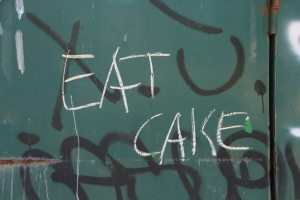Whenever I travel I keep an eye out for evidence or histories of contention, protest and dissent, and I frequently come across interesting stories. I recently got back from a family holiday in Sorrento, a mid-sized city in the Italian province of Campania. As well as the city of Naples, Campania is home to some of Italy’s most popular tourist attractions, including Vesuvius, Pompei and the Amalfi Coast. During my holiday, I came across several examples of protest and contentious politics, both historic and contemporary.
Pompei is perhaps the most famous tourist attraction in Campania, a Roman city buried during an eruption of Vesuvius in 79 AD, and remarkably well preserved as a result. The city has 2 amphitheatres that are open to the public, one of which was the site of a riot in 59AD, between the local Pompeians and the residents of a nearby town called Nuceria. What started as an exchange of taunts and insults at a gladiatorial competition escalated to the throwing of stones, and finally the drawing of weapons. Casualties were suffered on both sides, although the Nucerians apparently came off decidedly worse. It seems likely that the riot was the culmination of long-term resentments between the citizens of the two towns. As punishment, the Pompeians were banned from holding events in the amphitheatre for 10 years. This story helped me to repopulate the ghostly archeological site, and imagine what Pompei was like before its tragic and sudden destruction.
Of course Campania is not just a tourist destination, it is also a region where millions of people live, and express dissent. Although I don’t pretend to be familiar with Italian politics, or the Italian language, there were quite obvious signs of contemporary contention as we travelled around. I found several stickers for a Naples anti-fascist group (see image below). The first one I noticed was on a train station platform. The local train network seemed to be a focus point of graffiti and stickers, so the anti-facism sticker did not seem out of place. The second time I spotted the sticker was in a much more incongruous location. At the top of Vesuvius there is scientific equipment to monitor the volcano, and provide advance warning for any future eruptions. One such monitoring station was covered in stickers, including the same Naples anti-fascism one I had seen at the station.
The other example of contemporary contention I noticed was the acronym A.C.A.B. Standing for All Cops Are Bastards, it is something I have become quite familiar with in England in recent years. I was surprised to find it in Italy though, as I assumed that the phrase would be different in Italian. I noticed it several times however, graffitied on a wall near my hotel, and written in black marker on a train window. I was intrigued by the international quality of this radical sentiment.
The history of protest in London, let alone the rest of the world, is vast, and I will never be able to learn about all of it. However trying to find out the contentious histories of new place that I visit helps me feel like I am getting to know that place slightly better, as well as providing some interesting anecdotes when for when I get home!





Loved reading this thaanks
LikeLike